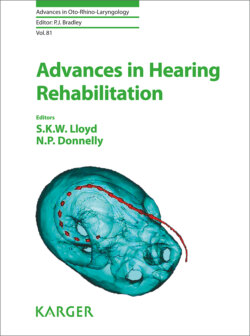Читать книгу Advances in Hearing Rehabilitation - Группа авторов - Страница 22
На сайте Литреса книга снята с продажи.
Clinical Utility
ОглавлениеThe potential utility and resolution of HiFUS has been demonstrated in a cadaveric study undertaken by the authors using a 50 MHz annular array [17], demonstrating detailed resolution of individual ossicles and the basilar membrane through the round window. Vibrations of the basilar membrane in human cadaveric temporal bones in the region overlying the round window have subsequently been measured, using a 45 MHz pulsed-wave needle mounted single element probe [3]. Imaging of normal and pathological ear structures, through the eardrum, in a saline filled middle ear has also been demonstrated using a linear 50 MHz array (Fig. 9) [19–21]. Dynamic movement of the middle ear structures, in response to indentation of the eardrum and acoustic stimuli, was also easily measured although the coupling fluid does influence these measurements to some degree.
Fig. 9. a, b HFUS images of normal middle ears collected using a commercially available HFUS unit (Vevo 2100; VIsualSonics, Canada). Many structures are apparent, including the tympanic membrane (TM), malleus handle (MH), long process of the incus (LPI) and stapes (St). It is important to note that the imaging probe used for collecting these images could not be used clinically, as the ear canal must be totally removed due to the probe size and limited viewing depth of 10 mm (Fig. 1c, d). Good continuity contact between the tympanic membrane (TM), a cartilage interposer, and the head of a total ossicular replacement prosthesis (TORP) was observed (top-left panel), as was good contact between a partial ossicular replacement prosthesis (PORP) and the head of the stapes (St; top-right panel). Scale bar = 1 mm.
The cochlea is difficult to access through the otic capsule, because of the inability of ultrasound to penetrate bone but by decalcifying human temporal bones, it is possible to see areas outside the field of view afforded by the round window, and visualize a large portion of the basilar membrane. Figure 10 shows a decalcified cochlea with a cochlear implant inside it. This could be a powerful tool for understanding how implants interact with the structures inside the cochlea, as the imaging is dynamic, and the path of the electrode array can be followed.
Because linear arrays are too large to fit through the ear canal, a 64-element phased array that can fit into the ear canal is currently under development, and may even be able to look into the cochlea through the round window [22].
Fig. 10. HFUS images of a decalcified human cochlea with a modiolar image section plane, collected using the VisualSonics imaging system. The right panel shows the same cochlea implanted with a Cochlear slim straight array (implant aspects labelled with italics). RWM, round window membrane; BM, basilar membrane; RM, Reissner’s membrane. Scale bars = 1 mm.
